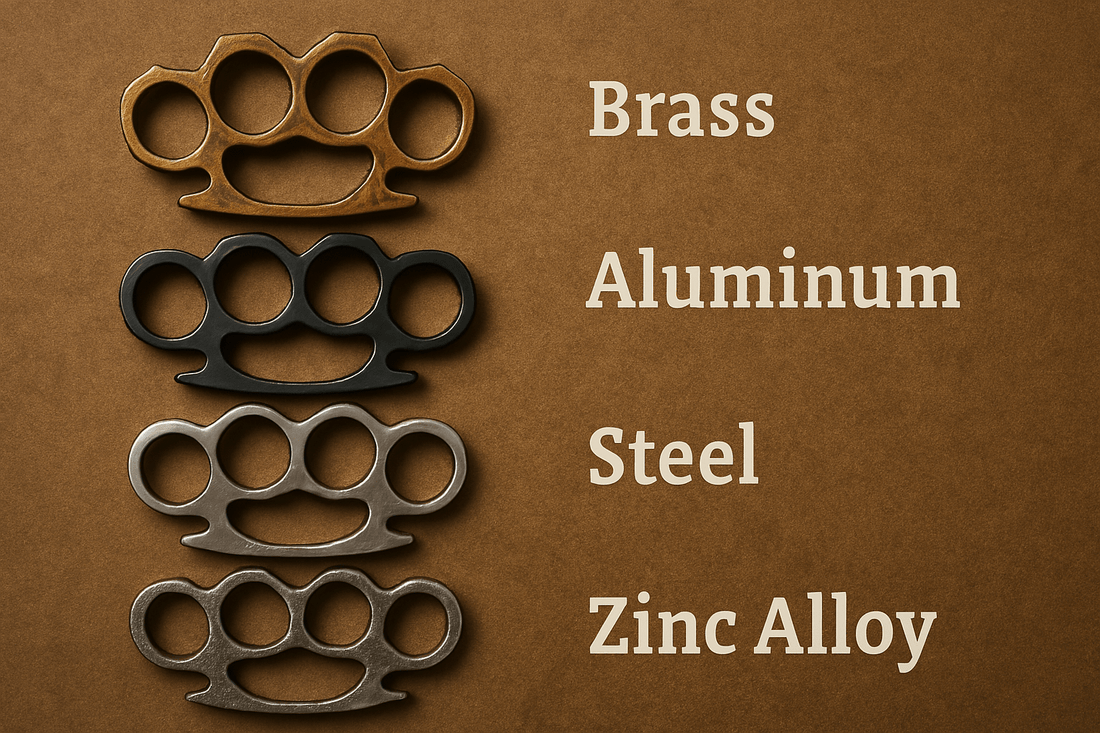When it comes to buying brass knuckles — whether you're collecting, displaying, or using them for legal self-defense purposes — material matters. The metal (or alloy) used directly affects the durability, weight, and visual appeal of the piece.
In this guide, we’ll break down the most common materials used in brass knuckles, comparing them side by side so you can make the smartest purchase for your needs.
🥇 1. Brass — The Classic Choice
Durability: ★★★★☆
Weight: ★★★★☆
Style: ★★★★★
Why choose it?
Brass is the OG — hence the name. It’s known for its vintage golden sheen, heavy weight, and solid impact resistance.
-
Often used in historical and collector’s editions
-
Naturally resistant to corrosion
-
Develops a patina over time, giving it a rugged, aged look
Best for: Collectors, display pieces, and traditionalists who want something with historical flair.
🛠 2. Aluminum — Lightweight and Modern
Durability: ★★★☆☆
Weight: ★★☆☆☆
Style: ★★★★☆
Why choose it?
Aluminum is a favorite among users who want something easier to carry and handle.
-
Lightweight yet strong
-
Can be anodized into a wide range of colors
-
Often used for custom, modern designs
It’s not as tough as brass or steel, but it's more practical for daily carry (where legal) and feels smooth in the hand.
Best for: Lightweight collectors, first-time buyers, or those who prioritize carry comfort and custom colors.
🧱 3. Steel — Built Like a Tank
Durability: ★★★★★
Weight: ★★★★★
Style: ★★★☆☆
Why choose it?
If you're all about strength, steel is the most durable option — it’s virtually indestructible.
-
Can handle heavy impact without warping
-
Weighs more than most other materials
-
Typically has a polished or brushed finish
Keep in mind, it’s heavier and less refined in appearance than brass, but it’s a beast in terms of toughness.
Best for: Hardcore collectors and those who value strength over style.
🧪 4. Zinc Alloy — Budget-Friendly, But Risky
Durability: ★★☆☆☆
Weight: ★★★☆☆
Style: ★★☆☆☆
Why choose it?
Zinc alloys are often used in low-cost brass knuckles — but be warned:
-
Cheaper to produce, but prone to cracking under stress
-
Often found in mass-produced or novelty pieces
-
Looks decent, but wears down faster
Best for: Decorative collectors or buyers on a tight budget. Not recommended for serious use.
💎 5. Titanium — The Premium Option
Durability: ★★★★★
Weight: ★★★☆☆
Style: ★★★★★
Why choose it?
Titanium is ultra-strong, corrosion-resistant, and has a high-end, matte-gray appearance.
-
Lighter than steel, tougher than aluminum
-
Expensive — but worth it for elite collectors
-
Hypoallergenic and practically indestructible
Best for: High-end collectors or those who want the ultimate in quality and rarity.
🔍 Side-by-Side Comparison Table
| Material | Durability | Weight | Style | Cost |
|---|---|---|---|---|
| Brass | ★★★★☆ | ★★★★☆ | ★★★★★ | $$ |
| Aluminum | ★★★☆☆ | ★★☆☆☆ | ★★★★☆ | $ |
| Steel | ★★★★★ | ★★★★★ | ★★★☆☆ | $$$ |
| Zinc Alloy | ★★☆☆☆ | ★★★☆☆ | ★★☆☆☆ | $ |
| Titanium | ★★★★★ | ★★★☆☆ | ★★★★★ | $$$$ |
🧠 Final Thoughts
Choosing the right material for your brass knuckles comes down to what you value most:
-
Want that classic, vintage vibe? Go with brass.
-
Need something lightweight and colorful? Pick aluminum.
-
Craving maximum durability? You can’t beat steel or titanium.
-
On a tight budget? Stick with zinc, but know what you’re getting.
💥 Want to See the Difference for Yourself?
Browse our curated collection of high-quality brass knuckles, available in a range of materials and styles — only at Brass Knuckles Shop.
➡️ Quality, legality, and craftsmanship — all in one place.

